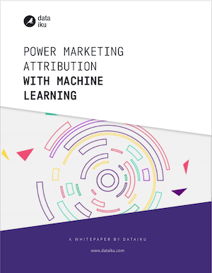Bad news: if you’re relying on heuristic marketing attribution models to measure the effectiveness of your campaigns (which many people do), they probably are not very accurate. This is assuming you do marketing attribution at all — which, by the way, you should be doing. But good news: there is a better way.

Spoiler alert, the solution is to use data science for marketing attribution. Hey, more good news though: we have a step-by-step guidebook (for non-technical readers as well as with code samples for the more technical crowd) that goes through the process of implementing a more effective model — get it here.
The Problem
Historically, marketing attribution has been a painstakingly manual process that often turns out to be more difficult (and less effective) than desired. And unfortunately, due to their relative simplicity, many marketing teams turn to single-source /single-touch attribution or other heuristic models, which are based on simple rules (like tying desired outcomes to a single source along the customer’s journey or assigning equal credit to all channels across a journey).
Yet on average, it takes six to eight touches to generate just one viable sales lead. And that means, with rare exceptions, heuristic models for marketing attribution are a gross oversimplification and generally come with inaccuracy.

On average, it takes six to eight touches to generate just one viable sales lead
Obviously this is especially true for products and services the longer the sales cycle, which means many touches along the way and the fact that a combination of messages could have led to the desired behavior. Heuristic models also introduce a great deal of bias; for example, last- or first-click models can place unwarranted emphasis on retargeting or Google search as effective ad targeting platforms.
The Solution
Marketing attribution is the perfect space for data science, which can incorporate vast amounts of data from various sources to help marketers understand in a scalable and more detailed way where the best (and worst) conversions are coming from. In other words, it can help assign the right amount of "credit" to the various channels a user may have interacted with along their customer journey. From there, marketers can adjust spend (either manually or automatically) accordingly.
Convicted and ready to start your new-and-improved marketing attribution project? We thought you might be. Right this way to get a step-by-step walkthrough (with background and simple explanations for intermediates and code for the more advanced).
In this guidebook, you'll find:
- An in-depth look at common marketing attribution methods and the advantages / disadvantages of each.
- A step-by-step walk through on how to build an algorithmic attribution model, including code for technical users and explanations for non-techies.
- A look at common missteps in marketing attribution (+ specific solutions).
- Articles and interviews with experts.





